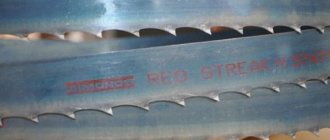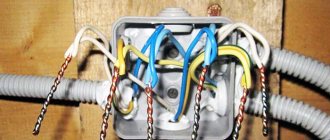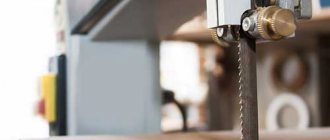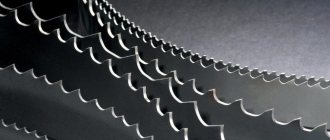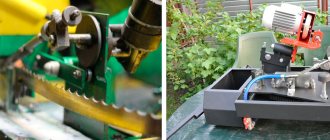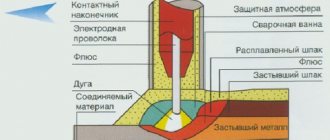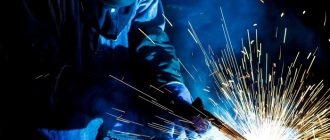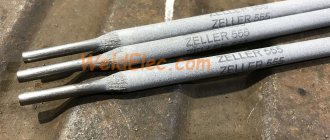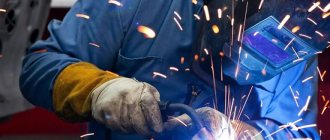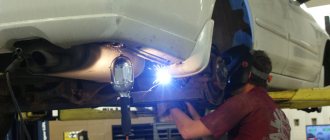Protect your eyes | 11/27/2018
Band saw tools are constantly subject to tensile stresses, causing the saw blades to break frequently. Despite the fact that tool steels are not very readily welded, welding the saw blade is considered the only way to restore the functionality of the blades. For which, of course, you will need a machine for welding band saws.
Models and principles of their selection
Machines for electric welding of band saws using the contact method are selected according to the following parameters:
- Power (including circuit breaker).
- The presence of an overload fuse.
- Range of changes in clamping force and the possibility of its automatic adjustment.
- Method for changing RC resistance: for small ranges, it is necessary to more carefully monitor the condition of the surface of the clamping jaws.
- The material of the clamping jaws (its hardness when hot and the presence of an anti-corrosion coating).
- The presence of a built-in pyrometer, by which the operator can judge the heating temperature of the ends of the band saw.
Among the powerful machines for resistance welding, it is worth highlighting the Swedish-made ESAB ZFR 10 BT machine. It operates from a DC power source and can weld saw blades up to 160 mm wide, with a maximum clamping force of 1200 kN, and a hydraulic unit is used for compression. The machine drive is automatic, including a device for subsequent burr grinding. Annealing of the finished section is carried out according to a program, depending on the purpose of the band saw and the grade of steel from which it is made.
Similar equipment of domestic production is the machine model ASP-1600. Its technical characteristics:
- Width of the welded blade, mm – up to 90.
- Power, kVA - 4...9.
- Supply voltage, V – 380.
- Productivity, cycles per hour – up to 10.
Among mobile units for similar purposes, we note the G10-60 from the Italian company Griggio. The machine is compact, equipped with an automatic clamping force control device, and has the following operational parameters:
- Width of the welded blade, mm – up to 60.
- Power, kVA - up to 4.5.
- Supply voltage, V – 220.
- Productivity, cycles per hour – up to 15.
The delivery set includes scissors for pre-trimming defective saw ends.
Rail cutter. Adjusting paths without any hassle
Dynamic density meter D-51. Checking soil compaction
Ranges
The IDEAL-Werk company has existed since 1923. Since that year, the founder of the IDEAL-Werk company, Clemens Jungelblodt, has been developing technologies for soldering band saws and then butt welding. IDEAL-Werk has the greatest experience in this area.
In addition to BAS butt welding machines for flash welding, IDEAL produces:
- resistance butt welding machines – BSS machines;
- electric arc MIG-MAG or TIG welding machine BLS (for wide strips of wood).
On machines from the BAS range it is possible to weld
- wood strips with a width from 5 to 206 mm;
- metal strips with a width from 3 to 105 mm;
- band knives for textiles, foam rubber, etc. width from 5 to 120 mm;
- stainless steel band saws with a width of 5 to 60 mm;
- low-carbon steel strip with a cross-section of up to 360 mm².
Classification of band saws
According to their design features, band saws are:
- Cantilever (pendulum) band saw - in its manufacture, a special saw console is used, which rises and falls due to the rotational actions of the hinge. This type is used for sawing stainless steel pipes, prepackaged profiles, and rolled products.
- Single-post - they are based on a horizontal saw frame that descends along a vertical post. Its design parameters are similar to a radial drilling machine. The main advantage of this type is the ability to cut metal products at an angle.
- Two-post saws also use a horizontal saw frame that moves along 2 vertical columns. The connection to the frame is made using a rigid closed loop. The advantage of two-post saws is considered to be high levels of competition; the tool can be used for cutting any metal.
- Portal machines - consist of a fixed working area and a movable portal for cutting, on which it is possible to process materials of large dimensions (plates, castings). The advantage of the tool is its compactness: since the portal moves along the linear guides of the desktop, the equipment does not require much free space.
- Vertical band saw for metal - designed for both straight and curved cutting along external and external contours. Operating principle: the workpiece is not clamped in a vice, but is held in the working area manually.
- Rotary (angular) - allow you to cut metal at different angles to the axis of the part. Their design is based on a rotary saw frame rotating around a vertical axis. This allows you to adjust the cutting angle in one movement.
By degree of automation
Manual (gravity) - the saw frame is driven by the use of the worker’s physical strength, as well as its own weight.
| Advantages | Flaws |
| 1. Price-quality ratio (low cost of equipment with high performance of the tool). 2. Possibility of adjusting the cutting angle (up to 60°). | 1. Significant vibration during operation, which leads to rapid wear of the equipment. 2. Lack of reliable automatic cleaning mechanisms. 3. The need for manual control of the pulley tilt level. 4. Lack of automatic control of the pressure force of the equipment on the workpiece. |
- Semi-automatic saws - all operations (clamping and opening the vice, lowering and raising the saw blade) are carried out automatically using a hydraulic drive. The worker's task is only to control the movement of metal. Processing of products is possible at an angle from -60° to +60°. Suitable for cutting heavy metals, including solid cast iron, non-ferrous alloys, and stainless steel.
- Automatic metal band saw - used in large industrial production. The operator's tasks are minimal: he only needs to set the metal processing parameters when placing the workpiece in a vice. The further process is automated, the sawing process is controlled by CNC. The equipment is characterized by the highest productivity, as well as high levels of accuracy.
By functional features
- Class I - saws are used in large industrial production for processing any type of metal (metallurgical plants, production shops, heavy engineering, etc.). The width of the canvas is at least 27 mm. The cutting surfaces are characterized by high strength, which ensures low wear rates and low cost per cut.
- Class II is a popular type of band saw. They are used in the procurement production of mechanical engineering enterprises for cutting non-ferrous metals, alloy steel, heat-resistant alloys, and titanium. The width of the tape web is from 20 mm.
- Class III - most often represented by console saws. They are used in small industries producing pipes and rolled profiles. A tool with low productivity and high tooth wear. The width of the canvas is from 17 mm.
- Class IV - small-sized, lightweight devices used for cutting parts whose diameter does not exceed 50 mm. Class IV band saws are not used in industrial production. They are in demand in repair shops and for private use. The width of the canvas does not exceed 13-15 mm.
Model range, modifications and equipment of BAS IDEAL machines
Model range of BAS machines:
- semi-automatic machines for welding table-top band saws with manual clamps: BAS 040, IDEAL BAS 050 01, BAS 060-01
- semi-automatic machines for welding table-top band saws with hydraulic clamps: BAS 050-11, BAS 065-11
- automatic floor-mounted machines for welding band saws with pneumatic alligator-type clamps and pneumatic upsetting drive: BAS 051, BAS 052 (models discontinued since 2016, see BAS 310 and BAS 320)
- automatic machines for welding band saws, floor-mounted, with vertical hydraulic clamps and pneumatic drive upsetting: BAS 100, BAS 120 (models discontinued since 2016, see BAS 330 and BAS 340, and for wide band knives BAS 330 BM and BAS 340 BM)
- semi-automatic machines for welding band saws, floor-mounted for wide band saws on wood, with manual and hydraulic clamps and pneumatic upsetting drive: BBA 121, BAS 160, BAS 210 (models discontinued since 2016, see BAS 360)
- Resistance welding machines for band saws of the new (!) BAS 300 series: BAS 310, BAS 320, BAS 330, BAS 340, BAS 360
(Similar in characteristics to the previous series - BAS 051, BAS 052, BAS 100, BAS 120, BAS 210)
BAS machine equipment:
As standard, butt welding machines for band saws - BAS - are equipped with a button for manual annealing control, with visual temperature control.
As additional equipment, IDEAL-Werk offers:
- potentiometers for desktop machines for manual adjustment of welding current with visual temperature control;
- systems for pyrometric control and automatic control of the annealing cycle;
- automatic centering stop for automatic machines IDEAL BAS 051, BAS 052, BAS 100, BAS 120, BAS 310-340;
- automatic loading device for narrow webs for automatic machines IDEAL BAS 051, BAS 052, BAS 310, BAS 320;
- controller of welding parameters for automatic machines;
- hydraulic deburring device for automatic strip welding machines BAS (for models IDEAL BAS 100, IDEAL BAS 120, BAS 330, BAS 340).
Modifications of BAS machines:
- Horizontal clamps
- When using shaped electrodes, BAS machines are applicable as butt welding machines for welding other products: welding the shank to the working part of the tool (drills, spindles with a threaded end, etc.), welding parts of kitchen stoves, etc. and so on.
Preparation for welding
Before performing such a procedure on machine equipment, you must first understand the intricacies of the work:
- The joined ends of the blade are trimmed in such a way that the joining edges are positioned as closely as possible to each other and perpendicular to the cutting teeth (for minimal error, the metal must be trimmed using a guillotine).
- In case of restoration of a saw that has burst along the perimeter of the welding seam, it is worth trimming the blade, departing from the ends of at least 5 mm.
- The blade is cut strictly between the cutting teeth.
- Before joining, the connecting edges should be treated with a solvent to remove residual dirt and cleaned using sharpening equipment or using an angle grinder with an appropriate fine attachment.
Welding Features
If part of the band saw breaks, it is necessary to prepare the blade for welding. The oxide film is carefully removed from both surfaces, since such a film interferes with reliable welding, and sometimes completely interrupts the process. After degreasing, wipe the area with a damp cloth.
The next preparatory stage is grinding the ends of the saw blade to be welded. At home, a router is used for these purposes, and if the edges of the blade are securely fastened on a bench, an ordinary grinder with a fine-grained abrasive disc will do. The edges are sharpened at an angle of 45º and then applied to each other, making sure that there is no visible gap between them.
It happens that a torn saw blade is deformed. Welding band saws for metal with a twisted blade is impossible, so you will have to first conduct a tempering, the mode of which is selected according to the steel grade. For band saws that are made of high-speed steels, the tempering mode consists of heating them to 300...400ºС, holding them at this temperature for 2...3 minutes and then slowly cooling them in still air. Band saws made of carbon alloy steels are tempered at a lower temperature - 180...250ºС.
Edge welding can only be butt welding.
Processing of sheets after welding: annealing and cleaning
During the welding process, the joint, along with strength, also acquires fragility. One targeted blow with a heavy tool breaks the integrity of the seam.
To restore elasticity to the joint, it is necessary to anneal it.
The implementation of such a process is carried out on the same machine equipment without disconnecting the web from the clamping mechanisms.
Annealing is performed by changing the current mode and reducing the forces on the blade.
With a gradual increase in current, the connection point is heated to a temperature of 500-550 degrees. Carrying out such a procedure involves the preliminary installation of a pyrometer that controls the increase in temperature exposure at the connecting point.
After reaching the required values, the electricity supply is stopped, after which it is necessary to wait for the canvas to cool.
When installing equipment and carrying out work in an unheated room, when the saw cools down, it is necessary to periodically turn on the current supply.
A sharp change in temperature on the surface of the canvas will lead to disruption of the technology and loss of strength characteristics. Normal cooling of the metal should take from 3 to 5 minutes.
Do not forget that some types of metal require double processing. Experienced specialists simultaneously carry out annealing during welding.
Cleaning after welding
The main requirement for such a procedure is the maximum removal of metal deposits and the creation of a clear weld geometry.
The procedure is performed with any abrasive material or tool.
The decisive factor here is the absence of any roughness on the surface of the saw. In this regard, the surface should be cleaned not in the classical way across the canvas, but along it.
How to make a band saw for metal with your own hands
In construction stores, band saws are quite expensive. With minimal skills, you can make the tool yourself. Some of the parts can be made by hand from recycled materials, and the missing components can be purchased in the store (they are low cost).
Materials and tools
Before starting work on the manufacture of a manual band saw for metal, it is necessary to prepare the necessary materials and equipment:
- grinder;
- screwdriver;
- grinding device;
- consumables (insulating tape, adhesive, fasteners, etc.);
- hand tools (screwdrivers, screws, knife, scissors).
To assemble a machine from scrap materials you need to find:
- wooden panels (will be used under the base and tabletop) - if chipboard is used, then several layers must be glued together to ensure the required strength indicators;
- channel, steel rods (will be required at the stage of creating the base for tensioning the rotating axes);
- rubber (bicycle or tire tubes) - will be used to secure the cutting belt to the pulleys;
- belt (useful for rotating disks);
- waterproof plywood with a thickness of 10 mm or more (will be used to make a protective cover);
- motor and wires (the choice depends on the required power of the device).
Rules for selecting tape
- When buying a cutting blade, look at the edge: all the teeth should be the same, evenly spaced from each other;
- Choose a blade that can be sharpened again;
- Depending on the format of the work, determine the required type of component:
- bimetallic - used when cutting durable materials, characterized by increased strength (the tool will last a long time, the saw is resistant to tears and tension);
- diamond - designed to work with marble, granite, quartz, stone;
- carbide - needed for sawing cast iron and titanium, can be used when processing complex workpieces;
- made of tool steel - a classic blade, suitable for one-time work with wood and metal, and is the least expensive.
Step-by-step instructions for making a handheld metal band saw
- Determine the planned purpose of using the machine and the required dimensions of the tool.
- Download from the Internet or make a drawing of the device yourself.
- Prepare your workplace, tools, materials.
- Make pulleys: you will need plywood or chipboard, the recommended diameter is 24-26 cm.
- The pulleys must be sanded and covered with rubber on the inside.
- Make a vertical axis: you can use a metal channel or durable types of wood.
- Prepare the base part of the base (any stainless steel will do).
- On both sides of the base, insert bushings onto which fasten the pulleys (item 4). The pulleys should be level, without tilting.
- If available, install a damper (under the tabletop): it will minimize vibrations and oscillations during operation of the machine.
- Secure the motor, ensure its strong connection with the rotating part of the tool (item 5).
- Assemble the tabletop from existing wooden panels and, if desired, cover it with an insulating layer. The tabletop should be placed on a strong, stable leg.
- If in your work you need to make straight longitudinal cuts, then you need to install guides.
- Install a controlled lubrication system above the tabletop: the oil should flow by gravity onto the saw blade (the amount is determined experimentally during operation of the machine).
- Attach a protective cover to the upper pulley: it is necessary to prevent the saw blade from slipping. The cover should cover the entire engine and electronics to prevent sawdust from getting into the mechanism.
- If you doubt that the engine can cope with large volumes of work, then it is better to install a residual current device (RCD).
- Cut off all sharp corners and sand the surface of the tool.
- Install the belt, tensioning it as much as possible (chain slack is not allowed). The tape must be positioned strictly parallel to the base to prevent the fabric from being removed.
- Carry out a test run of the machine, make a test cut on a thin steel or metal sheet.
Technical Specifications of Band Saw Welding Machines
| Model | BAS 040 | BAS 050-01 050-11 | BAS 060-01 | BAS 065-11 | BAS 051 (310) | BAS 052 (320) | BAS 100 (330) | BAS 120 (340) | BBA 121 | BAS 150 | BAS 160 | BAS 210 (360) |
| Rated power (50% duty cycle), kVA | 3,5 | 4,5 | 10 | 20 | 7,5 | 25 | 25 | 45 | 25 | 120 | 45 | 70 |
| Width of welded metal band saws (bimetallic, tungsten alloyed), mm | 3 — 27 | 6 — 34 | 10 — 41 | 10 — 54 | 6 — 41 | 6 — 54 | 15 — 81 | 25 — 105 | 67 — 130 | |||
| Width of band saws for wood, mm | 5 — 40 | 6 — 50 | 10 — 60 | 10 — 60 | 3 – 50 | 6 — 50 | 15 — 100 | 25 – 120 | 25 — 120 | 70 — 150 | 25 — 160 | 35 — 215 |
| Width of stainless steel band saws, mm | 5 — 20 | 6 — 30 | 10 — 40 | 10 – 40 | 6 – 30 | 10 — 50 | 25 — 50 | 25 – 60 | 25 — 60 | 30 — 80 | ||
| Width of band knives, mm | 5 — 20 | 6 — 30 | 10 — 40 | 10 — 40 | 6 – 50 | 6 – 50 | 25 — 80 | 30 -120 | 60 — 150 | 30 — 120 | 40 — 120 | |
| Max. cross-section of welded strip made of stainless steel, mm2 | 40 | 75 | 90 | 90 | 100 | 150 | 200 | 250 | 200 | 250 | 360 | |
| Max. clamping width, mm | 40 | 50 | 60 | 60 | 50 | 50 | 90(100) | 120 | 120 | 150 | 160 | 217 |
| Net/gross weight, kg | 80/100 | 140/185 180/220 | 250/350 | 290/390 | 460/560 | 460/560 | 600/700 | 625/725 | 300/- | 430/- | 660/- | |
| Packaging dimensions WxDxH, cm | 59 73 64 | 100 88 68 | 115 100 90 | 115 115 115 | 120 107 138 | 120 107 138 | 100 135 170 | 100 135 170 | — | — | — |
Processing the saw after welding
Immediately after welding, the saw is not suitable for use. In order to bring it into proper condition, several operations are carried out.
Weld annealing
When welding, the blade material hardens and becomes brittle. Annealing allows it to regain its plasticity and toughness. The saw is not removed from the machine, the draft is set to zero, and a different current mode is selected. By pressing the current annealing button, the seam is heated and then slowly cooled. If there is no pyrometer, the temperature is monitored visually. The optimal color of metal when heated is cherry red. Orange or yellow color indicates overheating.
Cooling lasts three to five minutes. Some fabrics require two cycles.
Stripping the canvas
When stripping the blade, the influx of metal is removed from the welded area, and the correct shape of the cavity between the teeth of the blade is brought out. Any abrasive is suitable for cleaning; a sharpening machine is best.
Technological features
It is worth considering that:
- The alloys from which saw blades are made are difficult to weld;
- When working, the welding seam is subject to extreme loads;
- The geometry of the teeth in the weld area affects the loads during operation.
Welding work
Welding of band saws is divided into several stages. At each technological stage, it is necessary to strictly adhere to the methodology in order to achieve the best result.
There are several types of devices that allow the connection process to be carried out. They usually function as follows: the edges of the ends of the saw are connected by joining them and passing current through them.
Resistance welding machines are one of the types of equipment that allow you to reliably connect the ends of a cutting tool. They are inexpensive, but their performance is low.
Such equipment is perfect for small volumes of work; it will be especially effective in repairing saws in industrial sawmills.
Band saw connection drawing.
This method assumes high quality preparation of the joint and electrodes, as well as the correct choice of modes. Devices operating on the reflow principle offer higher productivity. In addition, they are able to work with all types of fabrics. Such devices are classified as middle class.
The method also requires good surface preparation, correct choice of modes and consideration of metal consumption.
The saw welding process, as noted above, is divided into stages, each of which will be described below.
cutting
In addition to the saw welding machine, you will also need some other tools. These include guillotine shears, used for cutting fabric. If there is no such device, then you can use a chisel or cutting machine.
If a connection is made on a previously used area, five millimeters should be cut off on each side. The cut must be made strictly perpendicular to the teeth. A five-millimeter allowance is left on each side.
Stripping
Band saw welding.
The next step is to strip the saw blade. For these purposes, it is necessary to thoroughly clean the surface of the instrument. Acetone or alcohol can be used as solvents.
In addition to contaminants, burrs and irregularities must be removed. The easiest way to do this is on a sharpening machine.
Installation
After preparing the web in accordance with the steps listed above, the web is installed in the welding equipment. The edges of the product must coincide with each other.
Equipment parameters such as force, mode and course of upsetting are set based on the material selected for the web. The required modes are contained in the tables given in the documentation for the equipment.
Welding
If professional equipment is used, butt welding of band saws is started by turning the corresponding knobs or pressing a button. Current is supplied to the electrodes, passes through the joint, heats the metal to the melting point and connects the ends of the sheet to each other.
One of the essential parameters is the current supply time. In automatic equipment it is one to two seconds. If welding is done by hand, then the time is set by the master.
In case of unsuccessful connection, the modes are changed to more suitable ones and recorded. In the future, these values can be used in the case of welding the same sheets.
Annealing
Band saw preparation processes.
Immediately after making the connection, the saw is not suitable for use. To prepare the tool for use, it is necessary to perform several more operations with the blade.
Welding machine
You can control the annealing temperature using a pyrometer. In case of its absence, control is carried out visually based on the color of the metal. The most optimal color is cherry-red, but orange or yellow indicate overheating.
Stripping
The final stage is to clean the joint from the deposited metal. It is also necessary to obtain the correct shape of the cavity between the teeth. For these purposes, you can use any abrasive. However, as mentioned earlier, a sharpening machine is best.
Technology
The strip web is unwound from the coil and cut to size, taking into account the allowance for melting and upset and taking into account the preservation of the tooth pitch after welding. Although for flash butt welding on BAS type machines the quality of end preparation is not as important as for resistance butt welding (see BSS resistance welding machines), but still, the higher it is, the greater the chances of getting a good seam. Therefore, it is important to use good guillotine shears for cutting band saws (see guillotines AHE, APE from IDEAL-Werk) to obtain a joint without burrs and strictly perpendicular to the back of the band saw.
For large volumes of production of ring-welded band saws and knives, special machines are used for unwinding the saw from a coil and measuring cutting taking into account the tooth pitch (see machines for unwinding and automatically cutting a band saw to size from a coil).
Next, the ends of the blade (or strip) are clamped in the clamp jaws of a butt welding machine for welding BAS band saws. For welding small flat sections, as in this case, a current supply on one side is sufficient, so the electrode jaws are located on the bottom side, and on the opposite side are hardened steel pressure plates or segments. The installation of the saw to be welded in the jaws is carried out with the ends centered at the center of the adjustable distance between the clamps, called the installation length.
The drive of the clamps in BAS butt welding machines, manual, pneumatic or hydraulic, is implemented in proportion to the maximum applied upsetting force. Next, after starting the welding cycle, a slight pressure is applied to the ends through a movable clamp to create electrical contact and an electric current is applied (in fact, the pressure cyclogram is a little more complex, but the above reflects the essence). The movement of the movable jaw with the clamped end of the band saw is controlled by a motor through cams. The upsetting force is not applied to the joint immediately, this is what distinguishes the method from the resistance welding method implemented in the “devices” for welding band saws using the BSS IDEAL-Werk resistance welding method. In the melting interval of the welding cycle, the contacting peaks of micro-irregularities of the ends instantly melt and explode due to the high density of the flowing current, causing abundant sparking and splashing of metal in the plane of the joint. As a result, oxides, fats and other contaminants are removed from the joint, and if the planes of the ends are not aligned due to relatively poor trimming, then as a result of melting, their alignment occurs.
At the end of the melting interval, when the cam rotates to a certain angle, the full specified upsetting force is applied to the movable clamp by a spring, pneumatic or hydraulic drive. Adjustable parameters of the welding cycle:
- welding current
- welding time
- upset force (with sufficient clamping force)
- movement of the movable jaw during upsetting under current
- time and distance of melting (in a general sense – a cyclogram of the process)
After welding band saws made of alloy and high-carbon steels, it is necessary to anneal the seam to restore the ductility of the weld metal. In semi-automatic tabletop butt welding machines for welding band saws models BAS 040, BAS 050, BAS 060 and BAS 065 manufactured by IDEAL-Werk, the opening of the clamps to the installation length increased for annealing and the centering of the seam is done manually. In the fully automatic butt welding machines for band saws and knives BAS 051, BAS 052, BAS 100 and BAS 120 (discontinued) and in the new generation BAS 3xx machines, the clamps are moved apart and the band saw is re-engaged while maintaining the centering of the seam between the clamp jaws.
Annealing is carried out with visual control by the operator of the annealing temperature by the color of the heated metal and time control with a button. By installing the potentiometer, you can adjust the annealing current. When installing a pyrometric control and annealing control system on a butt welding machine for welding band saws BAS, you can set annealing programs and carry out annealing in automatic mode.
During contact butt welding, a burr with sharp, torn edges is formed on the seam. It is cleaned on grinding (cleaning) machines SMH and SMP manufactured by IDEAL-Werk, using abrasive cup-shaped wheels. Devices for stripping seams on band saws after welding are equipped with clamps with pads and an adjustable backing for the blade under the seam. The selection of grain size, its hardness and binder is also important so that abrasive wheels are consumed less and the seam does not burn out, i.e. repeated heat treatment as a result of heating when deburring with abrasive. Deburring is an important operation after welding a band saw because... its remains will act as stress concentrators during operation of the band saw.
When butt welding strips in continuous lines, automatic welding machines IDEAL BAS 330 (or BAS 100) and IDEAL BAS 340 (or BAS 120) flash welding are advantageous in that the welding cycle time and automatic seam cleaning are quite short (10 -15 seconds with the deburring device installed), which is important for lines operating at high speeds.
Band saw welding machines and electrode materials
The material for the electrodes must be of a solid type and also conduct electricity well. Copper is soft, so it is not recommended. In most cases, bronze is used for this, but at high temperatures it begins to move on the surface of the electrode, and its properties and conductivity undergo changes. When more than 25 welds are carried out, it becomes unsuitable for work.
Automatic brass is often used in electrodes, but zinc and lead often change the resistance. Therefore, the electrode very quickly becomes unsuitable for further use.
Annealing of welds
Low-alloy blades should be annealed at temperatures from 420 to 450 degrees, while alloyed ones should be annealed at 630 and higher.
Usually the manufacturer indicates the recommended temperature for annealing, there are several reasons for this:
- annealing is not an independent process, but is included in the welding mode;
- the time period for changes in the metal and its structure is directly dependent on the temperature regime, so that the section is heated evenly, it is recommended to use low temperatures for a longer process;
- The most optimal is considered to be step-type annealing, that is, the first heating is maintained and equalizes the temperature over the entire cross-section, and then rapid heating and cooling occurs;
- The heat treatment mode is adjusted after debugging the welding mode;
- do not rush and release the clamps immediately after welding; the material on the electrodes must cool completely;
- You should not immediately pull out the saw after welding for cleaning, because this part is quite fragile, so this can cause cracks to form;
- After blowing with compressed air has been carried out, you need to pull out the product, blow it again on all the necessary places and then fix the product for annealing.
There is an opinion that when blowing electrodes, linear guides wear out faster. However, high-quality devices provide for sealing the bearings with oil seals, so this does not affect the subsequent use of the products.
Band saw welding equipment
Scheme of resistance butt welding.
In a standard machine, saw welding is carried out in the following order: first, the blade is installed in the machine, then it is fixed with clamps, and then it is precisely brought to the electrodes through which current passes. This process allows the ends of both objects to be melted and welded. It is also worth knowing that the current passes through the electrodes, which, in turn, are secured with clamps. Today there are many brands and models of such devices, but they are conventionally classified into three types.
Equipment for resistance welding. The main advantages of this equipment are its fairly low cost and small dimensions. At the same time, their productivity is low, and it is designed only for a small amount of work and the production of a small batch of saws. Reflow welding equipment. Its performance is noticeably higher than that of previous devices, but the cost and dimensions have also become larger. Devices belonging to the middle class can be used for all types of fabrics
It is very important that they can even melt bimetallic sheets, which are often used for such products. Automated equipment for flash welding. This kind of equipment is installed in large workshops and factories or in service centers
Its productivity is very high, and the process is fully automated. The machine operator only needs to install the saw blades into the equipment and remove them after completing the welding process.
Band saw soldering
In the absence of a welding machine, the saw blade strip is soldered. To do this, it is degreased, the ends of the sheet are heated with a gas burner and the following operations are carried out - flux is applied and melted with the same burner, connecting it with a piece of brass by diffusion:
- Let's put a piece of brass on the end of the blade, melt it in the flame of the burner - during the melt, the saw steel diffuses with the molten brass at the atomic level. We use borax or special flux PV209X as a flux.
- We build a special device similar to the movable and fixed clamps of a machine for welding saws.
- We secure the ends and apply flux to both ends.
- Align the ends of the tape with an overlay on 2 teeth, align.
- We insert a piece of brass between the sheets and heat this place with a burner.
- As the melt forms, we connect the canvases.
- We are waiting for it to cool completely on its own.
- We grind the joint until the moment “enough is enough - it’s already smooth.”
The melting point of brass is about 900 degrees. The halves are heated to exactly this temperature. Instead of brass, you can use silver solders with a melting point of more than 900 degrees.
An overlay connection is easier, but it is more difficult to process the soldering area to the required thickness. This method is only suitable if it is impossible to use special equipment for welding.
Soldering
When the contact welding method is not available, high-temperature soldering is used with silver solders with a special borax-based paste flux. To secure the ends of the canvas, a simple homemade device is used. Heating is carried out by a gas burner.
Soldering is carried out according to standard methods. Flux is applied to the beveled ends of the saw. After clamping in the fixture, the joint is heated to the melting temperature of the solder placed nearby. Under the action of capillary forces, it will begin to be drawn into the joint. After solder appears along the entire connection line, heating stops. After cooling, the saw is removed and cleared of deposits.
General information
When joining the ends of the saw, it is necessary to take into account its load when processing parts, subjecting the tape to constant stretching and bending.
A band saw strip made from alloy or carbon steel can withstand the force of the material being processed, which sometimes cannot be said about a welded joint.
After a period of working hours, the seam bursts. Therefore, the latter must be made of a material of the same composition as the ring with teeth itself.
The latter is caused by uniform heating of the joints of the two parts being connected. After the described thermal operation, the ends are tightly joined, forming a one-piece ring.
Welding technology
Regardless of the type, welding of saws is carried out according to a single method, carried out in stages.
Fabric preparation
To ensure that the joined ends are even, the blade is cut using a guillotine. If you don’t have one, you can use a grinder or a mechanic’s chisel. When re-welding at the site of the destroyed old seam, 5 mm are cut off at the ends. The cutting line should run strictly between the teeth. A draft allowance of 1.5 mm is left at both ends. Using an abrasive tool, irregularities and burrs are removed. After cleaning the ends from dirt, they are degreased with a solution of industrial alcohol or acetone.
Welding process
After preparation, the ends of the blade are inserted end-to-end into the clamping device of the machine for welding band saws. It is necessary to make sure that the edges coincide in height and are located in the middle between the movable and rigidly fixed clamps. According to the attached table, current, force, and shrinkage progress are determined. Depending on the choice of operating mode, automatic or manual, the welding time is determined. In the first case it lasts several seconds, in the second it is controlled by the operator.
Band saw welding process
Before starting welding, you need to check the cleanliness of the electrodes, since dirt creates additional resistance. After turning on the device, current is supplied to the ends of the tape. At the point where they meet, the metal begins to melt. At the same time, the movable clamp begins to move by the amount of the specified shrinkage. As a result, a bead-shaped weld is created.
If the material of the band saw blade is unknown or is not in the table, the current parameters are selected experimentally using unnecessary scraps. When a satisfactory result is achieved, the settings are recorded for future use when working with similar products. Thus, an additional table is compiled where non-standard settings values are entered.
If it is not possible to use special machines, you can weld the saw at home. To do this, it is enough to have a simple welding machine and a vice. After preparing the canvas according to the method indicated above, its ends are clamped in a yew. To create a strong connection, it is recommended to use a filler metal rod for welding. After applying the suture, the fabric is turned over and the operation is repeated on the other side.
Annealing
The metal at the welding site becomes brittle when exposed to high temperatures. To return to its previous properties, it is annealed using the same machine for butt welding of band saws, without removing the blade. The settings set the stroke to zero and change the current mode.
After applying current, the connection area heats up to +600˚C. The temperature is controlled by pyrometer readings. If it is missing, they are guided by the color of the metal. A cherry red hue is considered normal. The appearance of orange or yellow color means overheating. When the required temperature is reached, the current supply stops. The optimal annealing time is 3 - 5 minutes. To prevent rapid cooling of the metal at low ambient temperatures, the current supply is turned on cyclically for short periods of time.
Depending on the metal, sometimes it is necessary to anneal twice. To increase productivity, it is possible to combine operations. Immediately after welding, current pulses are periodically applied to increase the cooling time. After manual welding, annealing is carried out using a furnace and oil.
Stripping
At the final stage, the roller is removed and the shape of the cavity between the teeth is restored. Cleaning is carried out using an abrasive tool. The emery wheel is directed not across, but along the seam. Its surface should be flush with the canvas.
Cleaning the weld seam of a band saw is carried out using an abrasive tool
Equipment
Machines for welding band saws are divided into stationary and mobile. The latter are pulsed units using the principle of a welding inverter. Stationary machines for welding band saws operate on a three-phase 380 V network and have increased technological capabilities.
The sequence of operation of the machine for butt welding of band saws is as follows. The workpiece is fixed in a clamping device, which has two sides. The left, stationary part is electrically isolated. The right one – movable – is connected to the ground electrode. After clamping the edges of the torn saw blade, both parts are brought closer together and clamping pressure is applied to them. The source of pressure can be:
- Mechanical transmissions of the “screw-nut” type (for portable devices).
- Spring (also used in homemade devices).
- Compressed air energy.
- Hydraulics.
Most designs use a pneumatic clamp, which is convenient since you will still need a fairly powerful fan to cool the welding machine.
During the heating process, the compressible edges of the blade melt. After this, the pressure must be maintained for some time in order to remove fusible impurities from the weld. At the same time, energy consumption is practically not reduced. This disadvantage is absent in machines for welding band saws, which implement the contact flash welding method. In this case, pressure is not applied to the workpiece all the time, but only at the final moment of the process, when the current (due to large gaps) has already heated the edge of the blade to a sufficiently high temperature.
Stages of welding work
cutting
First, the saw blade must be cut to a given length. You can use different tools for cutting. We recommend guillotine shears as they give the most even cut. The cut itself should be located at the top of the teeth. Don't forget to leave about 1-2 millimeters on the cut side for settling.
To achieve an accurate cut, you can use the technique shown in the picture below. After such cutting, the ends of the saw will be smooth and fit perfectly together. And this directly affects the quality of the weld.
Stripping
After cutting, the ends of the saw need to be cleaned. This is standard preparation of metal for welding. Clean the metal from dirt and traces of corrosion. Then degrease with any solvent. For example, acetone. Then clean the edges with an abrasive material. We use sandpaper. Make sure there are no burrs on the edges. Ideally, they should be smooth and even.
Installing the saw into the clamps
Above, we could already familiarize ourselves with the components that make up a machine for welding band saws. We said that there is a clamping mechanism. This is where the saw blade needs to be installed. The clamp has a movable and a stationary part. Place one end of the blade in the movable one and the other end in the fixed one. There is free space between the clamps. You need to install the canvas so that its joints are exactly in the middle of this space. Naturally, the joint must be smooth and precise.
Welding mode selection
Next you need to select the welding mode. If you have a simple welding machine, then all parameters need to be configured manually. The welding mode is selected based on the size of the saw and its cross-section. The larger the cross-section, the greater the welding current. These are general recommendations.
Typically, the welding machine comes with instructions that describe all welding modes depending on the size of the saw blade.
Also pay attention to the setting of the speed of current pulses. For budget models, it needs to be controlled manually, otherwise the metal will heat up too much
The recommended current supply time is 1-2 seconds. In more expensive devices, this parameter is adjusted automatically.
Welding
Welding for band saws begins with turning on the machine. The machine for welding band saws is launched depending on the model. This can be a separate button or a special handle. After starting, a welding current will be supplied to the ends of the saw, which will melt the metal in the area of the future seam. Current is supplied to the saw through the clamps. After heating the joint, the movable clamp must be moved slightly to form a weld bead. The seam is ready!
Make sure the electrode surface is clean before welding. It is not necessary to clean all the electrodes, just the part that is in contact with the saw blade is enough. If you ignore this rule, the connection will be of poor quality. Contamination will affect the circuit resistance.
Annealing
Next comes annealing. It is necessary because as a result of welding, the metal becomes too hard, which increases its fragility. Annealing helps return the canvas to its original condition. After pressing, the metal becomes plastic again, and its performance characteristics improve.
To perform annealing, you do not need to remove the blade from the clamp. Just set a different current mode. The main thing is to achieve a heating temperature of about 600 degrees. Expensive devices have a separate annealing function. But if you have a simple budget model, then you need to perform a few additional steps.
First of all, keep in mind that in addition to heating, you also need to cool the metal. And it is advisable to perform these operations one by one. Press the current supply button and hold it until the heating temperature appears on the display. Then release and let the metal cool. To ensure that the sheet cools evenly, you can periodically press the button again, preventing the metal from cooling quickly. Cooling time takes on average 5 minutes.
If your device does not have a display indicating the heating temperature, then you can focus on the color of the metal. Typically, the canvas takes on a cherry tint when the required heating temperature is reached. Do not allow the metal to become orange or yellow. Sometimes it is necessary to anneal twice.
Re-stripping
During annealing, visible sagging may form on the canvas. They need to be removed by re-cleaning. Now it is needed not for technical, but for aesthetic purposes. At the same time, you can correct the depressions between the teeth, giving them the correct geometric shape. Repeated cleaning can be done with any abrasive tool. Process the metal so that the joint is practically invisible.
Application
BAS band saw welding machines are the most common in the world and in Russia for welding band saws (of course, among companies providing professional services for welding band saws). Ideal-werk developed these machines before anyone else and has been refining these machines for TENS of years, and continues to improve. An example of the latter is the new generation of automatic machines for welding band saws - the BAS 300 series. The simplicity and sophistication of the design allows the machines to be “in service” for up to 20 years or more! No one has been able to repeat the success of Ideal Verka. Copies of BAS 050-01, such as the Chinese FL-50, are of course cheaper, but, among other things, they are not durable.
The main application of BAS butt welding machines from IDEAL-Werk is, of course, ring welding of band saws and knives. Many companies throughout the country provide services for the supply of ring-welded band saws and knives.
In addition, it is beneficial for factories with a large fleet of metal band sawing machines or woodworking factories with a large number of sawmills to have this joint welding machine in place in order to purchase blades in coils.
With a small number of sawmills (or when welding wood saws up to 50 mm for your own needs), we can recommend inexpensive, relative to BAS series band saw welding machines, BSS resistance welding machines for wood band saws. However, repairing saws on BSS resistance welding machines is not an easy task.
Do not forget that the machines for welding bandsaw blades of flash welding BAS are full-fledged butt welding machines of resistance flash welding and can also be used:
- for welding strip rings
- for joining workpieces made of high-carbon steels, alloy steels, spring and spring steels.
- when modifying electrodes and clamps, for welding small parts of round or rectangular cross-section.
